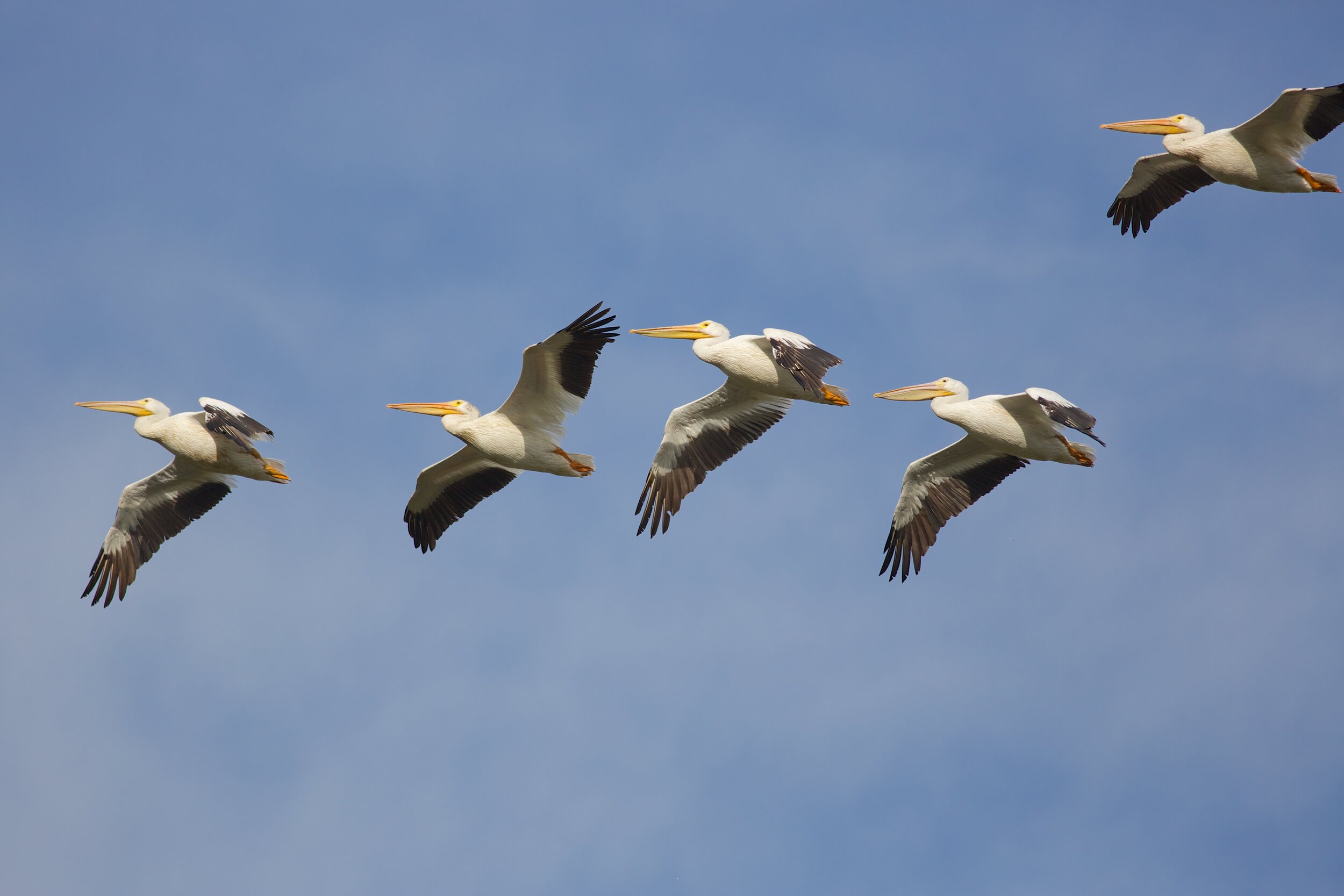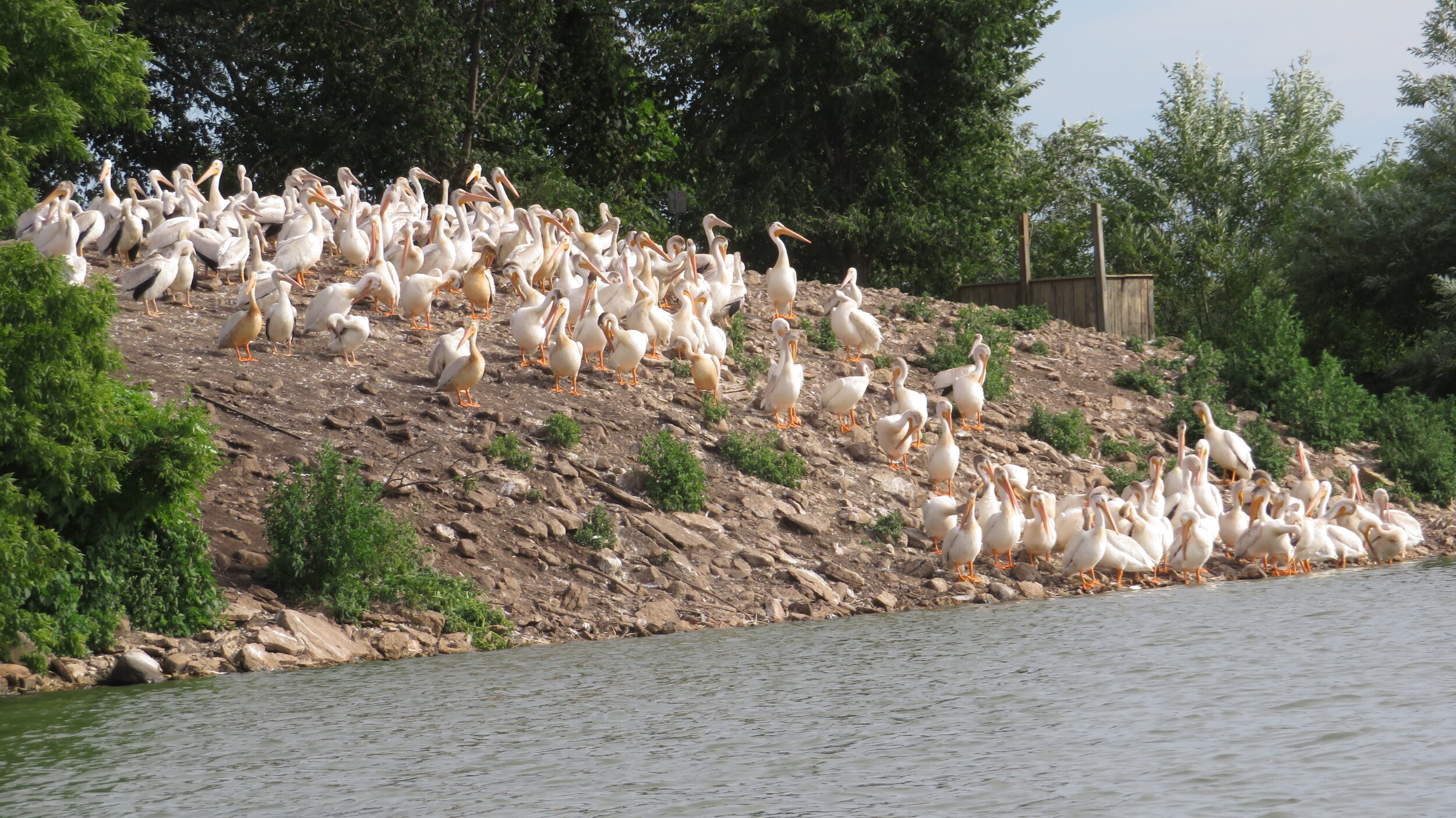We always enjoy seeing the American white pelicans and every time we see pelicans Mark always remarks, “The pelican, his bill can hold more than his belly can, the pelican”. This is from a limerick by Dixon Lanier Merritt:
“A wonderful bird is the Pelican.
His beak can hold more than his belican,
He can take in his beak
Enough food for a week!
But I'll be darned if I know how the hellican?”
Riding the thermals. Photo by Arlene Koziol
We enjoy seeing the pelicans soar gracefully in the thermals during midday against a blue sky or when they are “fishing”. They fish in a dense flock and move fish as a group to shallow water to make them easier to catch. Pelicans like to feed on rough fish including small fish such as minnows, carp, and bullheads. At Goose Pond we have an abundance of fathead minnows for them to feast on.
Pelicans have been around a long time and first appeared in fossil records 30 million years ago. Wildlife historian A.W. Schorger wrote in The White Pelican in Early Wisconsin, “The white pelican was first observed in Wisconsin by the famed adventurer Pierre Radisson. While in northwestern Wisconsin in about the year 1655, he observed a bird with a bill of 22 “thumbs” in length in which was held for a long time an entire salmon.”
So many “thumbs”! Photo by Richard Armstrong
Schorger examined records of wildlife observations up to 1900 including reading every paper that was published in Wisconsin and housed in the State Historical Society. For 15 years A.W. visited the Historical Society after work, and took notes of wildlife stories, eventually writing 25 articles that were published by the Wisconsin Academy of Arts, Science and Letters. UW-Stevens Point Wildlife students and staff assembled the articles in a 581 page book titled Wildlife in Early Wisconsin, Collection of Works by A.W. Schorger. Articles include Elk, Moose, Bison, Beaver, Quail, Wild Turkeys, Trumpeter Swans, Passenger Pigeons, and Rattlesnakes in Early Wisconsin.
In his article on the white pelican he found 63 references in 40 papers noting the birds during spring and fall migration. A.W. could not find any breeding records for our state. Pelican Lake in Oneida County was named for large numbers of migrating pelicans.
A pod of pelicans. Photo by Richard Armstrong
White pelicans were very common migrants up to about the 1860s. A.W. wrote “So large a mark was irresistible to gunners and it was apparent that the number of migrants declined sharply by about 1870.”
In 1991 Sam Robbins wrote in Wisconsin Birdlife, “The pelican has remained a rare migrant and summer visitant throughout the twentieth century. Since beginning publication in 1939, The Passenger Pigeon has recorded sightings in about 8 of 10 years, with from one to four reports per year.
Bettie Harriman wrote the account of the American white pelican in the first breeding bird atlas. She wrote, “Sightings began to increase in 1990, and Tom Erdman reported in 1994 the first documented nests for Wisconsin (and the Great Lakes) in the Green Bay area (Soulen 1995), unfortunately both nests failed.”
In the first Breeding Bird Atlas (1995 - 2000), 35 pelicans were found in 1995 along with nine nests in near Green Bay. Aaron Stutz entered the first pelican observations at Goose Pond when he found five birds on April 30, 1998. By 2000 they were found nesting at Horicon Marsh. In the second Breeding Bird Atlas (2015-2019) pelicans were confirmed nesting in 13 areas ranging from Door County to Marquette and Dodge County.
Breeding pelicans with their oh-so-attractive lobe or horn. Photo by Richard Armstrong
This spring has been a record year for pelicans in Columbia County. At Goose Pond we found a record-breaking 41 pelicans on May 29th and two days later Mark broke even that record with counting 59 pelicans. What a treat to see them soaring over the Kampen Road residence.
Pelicans nest on islands to avoid predators. It is interesting that both adults take turns incubating. Eggs are incubated under the foot webs of the parents. Two eggs are laid and usually only one chick survives.
The white pelicans main nesting area is on islands in large prairie lakes in North Dakota. The largest nesting location is at Chase Lake National Wildlife Refuge. In 1908 there were 50 pelicans in the area when President Teddy Roosevelt protected the area. In 2018 there were up to 40,000 pelicans in the area with most nesting on a 14-acre island.
Pelicans head south to the Gulf Coast for the winters. Young birds do not migrate north until they are two and females begin breeding at three years old. Some pelicans that we are seeing this spring may begin breeding next year.
At this time there are no nesting areas in Columbia County. The closest nesting island with a large population is High Island in Beaver Dam Lake in Dodge County. High Island is owned by Madison Audubon board member Pat Clark and his wife Angel. Last year we joined Pat, Dory Owen, and Dory’s husband Phillip to count 450 young pelicans that could swim but not fly. A group of young pelicans are called a pod creche. It was impressive to see a “creche” of pelicans, some of which may soar over Goose Pond in another year. Thanks to the Clarks for providing a great nesting place for an interesting bird.
A creche of pelicans at Clark's High Island in Beaver Dam Lake. Photo by Mark Martin
Many people reported high numbers of pelicans this spring in Columbia County at many wetlands including Schoeneberg Marsh Waterfowl Production Area/Erstad Prairie, Madison Audubon’s Otsego Marsh, Mud Lake and Grassy Lake State Wildlife Areas, and a flooded area at Harvey, Wangsness and DM. Another place to visit is Patrick Marsh/Brazee Lake on the northeast side of Sun Prairie. Goundswell Conservancy and DNR are protecting land around the lake. There is a trail system and observation area for pelican watchers.
We hope you can visit prairie wetlands and find these fascinating birds.
Written by Mark Martin and Sue-Foote Martin, Goose Pond Sanctuary resident managers
Cover photo by Arlene Koziol










